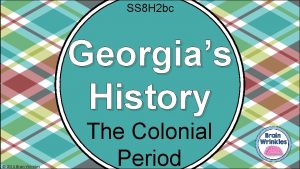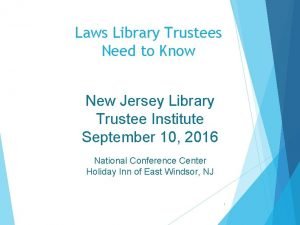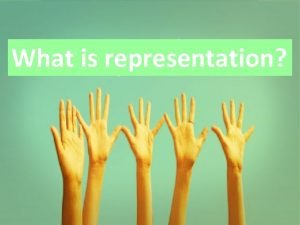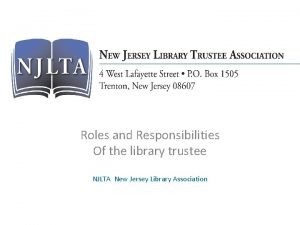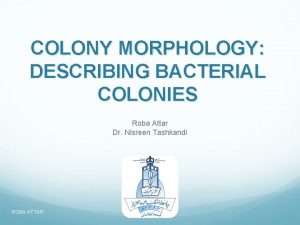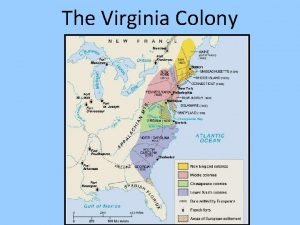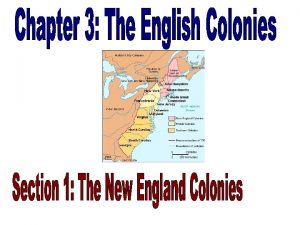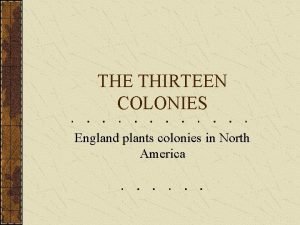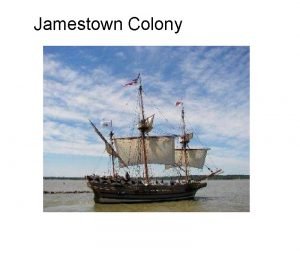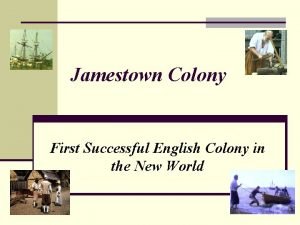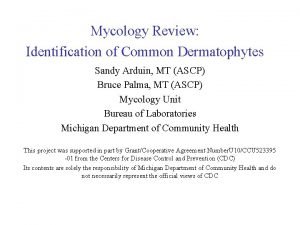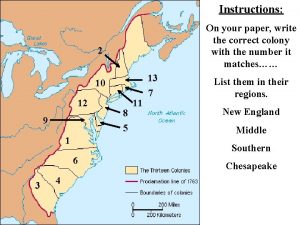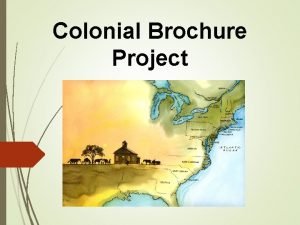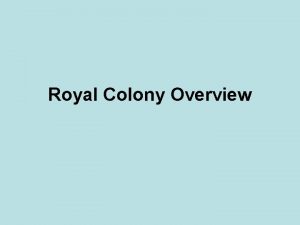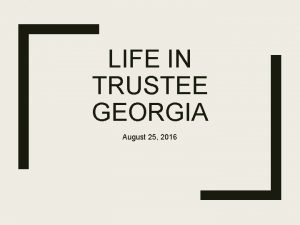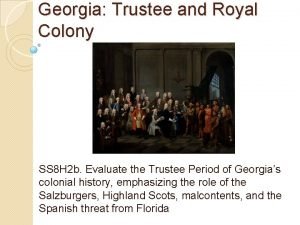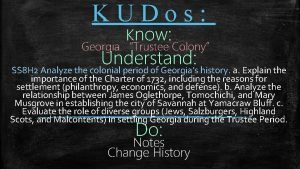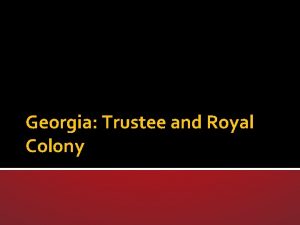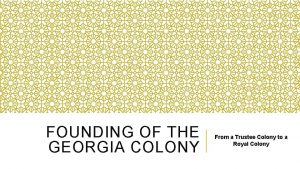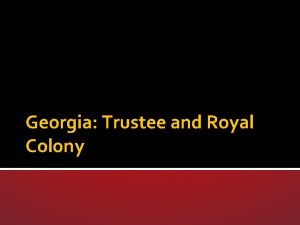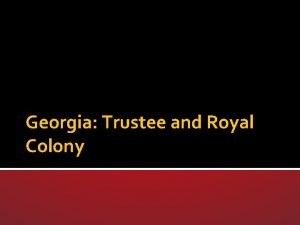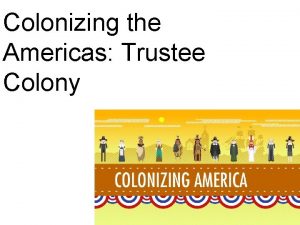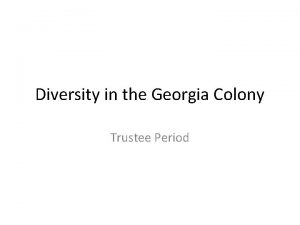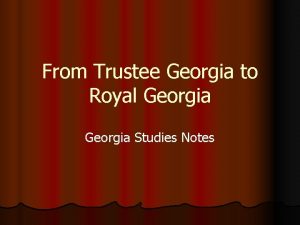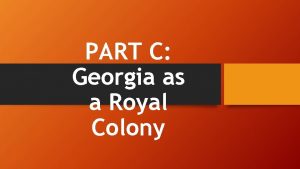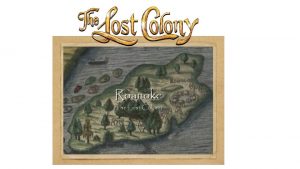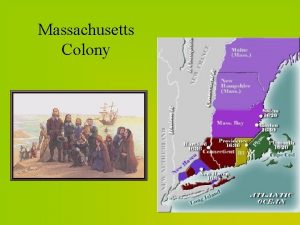Georgia as a Colony Trustee Georgia The Trustee































- Slides: 31

Georgia as a Colony

Trustee Georgia • The Trustee period in Georgia began when King George II gave permission to establish the colony in 1732. • For the first twenty years of Georgia’s colonial history, a group of trustees governed the colony. • A trustee is someone who oversees property on behalf of someone else.

Trustee Georgia • Georgia’s trustees managed the colony on behalf of England its ruler during this period, King George II. • The king granted James Oglethorpe a charter, which is written permission to begin an English colony. • The colony was named Georgia after King George.

Trustee Georgia • Before Georgia became a British colony, there was tension between the British and Spanish over the land. • This tension increased after the neighboring area of South Carolina became a British colony in 1670. • Spain maintained control of Florida.

Trustee Georgia • The land between South Carolina and Florida remained virtually unclaimed by Europeans • The original boundaries of South Carolina included the land between the Savannah and the Altamaha rivers. • This land eventually belonged to the Georgia colony.

James Oglethorpe • James Oglethorpe was a British soldier and a member of British Parliament, the legislative branch of British government. • Oglethorpe became interested in prison reform while he was in Parliament. • He saw that many people went to prison simply because they were poor. • These people were called the “worthy poor. ” • Because the worthy poor could not afford to pay their taxes, they often ended up in debtors’ prisons.

James Oglethorpe • Oglethorpe thought these people deserved a chance at a new life. • Oglethorpe believed that their best chance for a new life was in a new American colony. • He hoped Georgia would become a land where the worthy poor could thrive. • He also hoped it would be a place where Protestants could practice their religion.

Charter of 1732 • On April 21, 1732, King George signed the charter to establish the colony of Georgia. • This charter also established a governing board and created the trust to run the colony. • Seventy-one men served as trustees over the course of its period. • The trustees were not paid.

Charter of 1732 • The charter also said that trustees could not hold office or land in Georgia. • The charter did not set up any type of local government, but, it said that colonists had all of the same rights as British citizens.

Reasons for Settlement • James Oglethorpe and his supporters argued that creating Georgia was both charitable and economic. • Their motto was “Non sibi sed aliis”, which means “Not for self, but for others. ” • As an act of charity, the trustees paid for debtors to go to Georgia instead of prison. • They also thought removing debtors would aid the economy of England.

Reasons for Settlement • The trustees hoped the settlers would produce wine and silk to send back to England. • They required new settlers to plant mulberry trees for the raising of silkworms. • The trustees also argued that Georgia could help protect South Carolina from the Spanish.

Tomochichi • Native Americans had lived in Georgia for thousands of years before the arrival of European settlers. • When Europeans came to Georgia, they needed friendly relations with the Native Americans in order to establish a successful colony. • The chief of the Yamacraw Indians, Tomochichi, played an important role in creating peace between the Europeans and Native Americans in Georgia.

Tomochichi • He helped the many different groups in the area communicate with the British. • In 1734, James Oglethorpe brought Tomochichi and his family to England, where he met the royal family. • Tomochichi’s trip proved to be valuable to the Native Americans of Georgia. Tomochichi’s efforts led to the creation of a school for his tribe.

Tomochichi • His contributions in the peaceful negotiations between various Native American tribes and the British settlements in Georgia were celebrated with an English military funeral when he died in 1739. • Tomochichi built relationships between the Native Americans of Georgia and the British.

Mary Musgrove • Mary Musgrove was also a peacemaker. • She was the daughter of an English trader and a Creek Indian. • She was also related to several other Creek leaders. • Musgrove used her connections to both the British and Native Americans to help protect Native Americans and to maintain peace in the Georgia colony.

Mary Musgrove • She was also a trader and worked to expand her deerskin trading business. • Historians have compared Mary Musgrove to other great Native American women in the history of the U. S. , such as Pocahontas and Sacagawea. • Musgrove claimed to have royal heritage, but few scholars have accepted this claim.

Savannah • The city of Savannah, Georgia, was founded in 1733. • It was the last British colonial capital in America. James Oglethorpe designed the city. • It was very different from previous colonial towns.

Savannah • Its organization reflected many new European ideas about cities and buildings. • Great European cities such as Paris, France, were also designed during this time using the same ideas. • Savannah was built using connected neighborhoods and squares. • Each neighborhood, square, ward, and garden lot was of equal size.

Savannah • They were also arranged in a repeating pattern. • This pattern allowed the distribution of land to new settlers to be fair. • Commons surrounded the city. Commons are public lands owned by the city. • The commons allowed the city to expand later.

The Salzburgers • The Salzburgers were a group of Protestants who were expelled from Salzburg in the early 1730 s. • Salzburg is a city in present-day Austria. • The Salzburgers were expelled because they were not Catholic. • All Protestants were expelled at that time from the region.

The Salzburgers • The Georgia trustees and King George II sympathized with the Salzburgers. • They decided to support Protestant Salzburgers by extending an invitation for them to move to Georgia. • The Salzburgers arrived in Georgia in 1734, and established the town of Ebenezer.

The Moravians • Another group of Protestants were the Moravians from Bohemia, which is the present -day Czech Republic. • The Moravians came to Georgia in 1735. • Unlike the Salzburgers, who were expelled from the region, the Moravians came as missionaries. • They wanted to unite Christians and convert non-Christians.

The Moravians • Many other Protestants did not trust the Moravians. • They had many new and different ideas. • One of these ideas was that women could preach and hold religious offices. • The Moravian community was ultimately unsuccessful and eventually dissolved.

The Malcontents • Captain George Dunbar brought the Salzburgers to Georgia. • He also brought a group of Highland Scots. • In 1736, the Highlanders founded Darien, a town on Georgia’s southern border. • Later, the Highlanders would also become a group known as the Malcontents.

The Malcontents • Most of the Malcontents were colonists of Scottish descent. • Although the trustees aided many of Georgia’s settlers, they did not aid the Malcontents. • The Malcontents were wealthy enough to pay for their own voyage to Georgia.

The Malcontents • Because of this, they were not as loyal to the trustees or Britain. • The Malcontents wanted to purchase land enslave people with their great wealth. • They resented limits put in place by the trustees that prevented them from doing this.

The Spanish in Florida • Spanish settlers in Florida were not happy that so many new settlers were coming to neighboring Georgia. • The Spanish had been interested in the land that became the Georgia colony. • The British built Fort Frederica in Georgia in an effort to protect the colony.

The Spanish in Florida • Georgian soldiers made an unsuccessful attack on the Spanish mission of St. Augustine, Florida, in 1740. • Two years later, the Spanish attacked Fort Frederica. • The tension between British Georgia and Spanish Florida came to a head in the Battle of Bloody Marsh.

The Spanish in Florida • The Spanish retreated and never again attacked a British colony on the eastern coast. • Oglethorpe waged one more attack against Spanish Florida. • The attack was unsuccessful.

Royal Colony • During this campaign, Oglethorpe was requested back in England to answer misconduct charges against him. • Oglethorpe was found not guilty; however, he never returned to Georgia. • Oglethorpe remained on the board of trustees until 1750. • At that time, Oglethorpe disagreed with Georgia’s lack of restrictions on land ownership, rum, and slavery.

Royal Colony • In 1752, the British government did not renew funding for the colony. • The trustees turned over control of the colony to the British Crown. • Georgia then became a royal colony.
 Trustee colony
Trustee colony Compare and contrast trustee period and royal colony
Compare and contrast trustee period and royal colony Compare and contrast trustee and royal georgia
Compare and contrast trustee and royal georgia Similarities between trustee and royal colony
Similarities between trustee and royal colony Who governed the royal colony of georgia?
Who governed the royal colony of georgia? Trustee investment plan
Trustee investment plan Corporate trustee gaa
Corporate trustee gaa Trustee vs delegate vs politico
Trustee vs delegate vs politico Office of special trustee
Office of special trustee Trustee model
Trustee model Trustee period and royal period
Trustee period and royal period Fidelity personal trust company
Fidelity personal trust company Library trustees
Library trustees Trustee model
Trustee model Library trustee
Library trustee The oneida colony declined due to
The oneida colony declined due to Bacteria colony margin
Bacteria colony margin Jamestown advertisement
Jamestown advertisement Pilgrims
Pilgrims Deleware colony economy
Deleware colony economy King james jamestown
King james jamestown Crown or colony cheat sheet
Crown or colony cheat sheet Crt buffer test
Crt buffer test Neufeld quellung reaction
Neufeld quellung reaction Define proprietary colony
Define proprietary colony Rocky mountains geography map
Rocky mountains geography map Hair perforation test
Hair perforation test Colony
Colony Polymorphism in hydrozoa
Polymorphism in hydrozoa Daily life in colonial virginia
Daily life in colonial virginia New england colonies brochure
New england colonies brochure Was south africa a dutch colony
Was south africa a dutch colony

